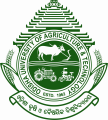Orissa University of Agriculture and Technology
The Radhakrishnan University Education Commission of 1949 emphasised the need for establishing Agricultural Universities in India., Subsequently, the indo-American team consistitued under the Chairmanship of Dr. K.R. Damle (1955), the then Vice-president of Indian Council of Agricultural Research, suggested a system of education for Indian as followed in the Land Grant Colleges of USA. The Planning Commission Committee felt the inadequacy of trained personnel for substantial output in agricultural operations with the then set up of research, education and extension in Agriculture, Animal Husbandry and allied fields. In course of time, these recommendations led to the creation of the agricultural universities to accomplish the integration of teaching, research and extension.
In 1956, Dr. J.H. Longwell from the University of Misouri visited Orissa and had discussion with the State Government which resulted in a contract between the Government of India and the University of Missouri to provide assistance to the Agriculture and Veterinary Colleges of the State. In 1960, a decision was taken to establish an Agricultural University in Orissa in the pattern of the Land Grant Colleges of USA and Dr. Ide P. Trotter joined the Utkal Krishi Mahavidyalaya on 1st April, 1960, as a consultant in Educational Administration. President Elmer Ellies of the University of Missouri, visited the Agriculture and Veterinary Colleges of Orissa in 1961 and had discussion with the State Government for establishment of the Orissa University of Agriculture and Technology.
In 1961, the Legislature of the State of Orissa enacted the Orissa University of Agriculture and Technology Act, 1961 (Orissa Act 20 of 1961) with the object of establishing and incorporating a University of Agriculture and Technology for the agricultural education of the people of the State. The University took its birth on 24th August, 1962 when it was inaugurated by Prof. John K. Galbraith, the then U.S. Ambassador in India. The University came into operation from 1st February, 1963, when the two Govt. managed Colleges, the Utkal Krushi Mahavidyalaya and the Orissa College of Veterinary Science and Animal Husbandry with their staff were transferred to the University. This Act passed in 1961, was later repealed in 1965 by the Orissa University of Agriculture and Technology Act, 1665 )Orissa Act, 17 of 1965) which came into fore from the 3rd November, 1965.
The University started a College of Basic Science and Humanities with the Pre-University Science class sin 1964 and in the following year the Pre-professional science class was added. The College of Agriculture Engineering and Technology came up in the year 1966.
In 1981, another College of Agriculture was started at Chiplima. In the same year, the College of Engg. & Tech., College of Home Science, College of Fisheries, Rangeilunda and PG Deptt. of Aquaculture, Bhubaneswar were established. In 1986, the Department of Forestry was started to offer the Bachelor's degree in Forestry under the College of Agriculture, Bhubaneswar.
In February, 1963, the State owned Agricultural Research Station at Bhubaneswar was transferred to OUAT. Subsequently, Berhampur, Jaypore, Chiplima, Kendrapara, Pottangi and Jashipur Research Stations were brought under the University. As the research areas were extended to more disciplines through aegis of several All India Co-ordinated Research Projects and ad-hoc schemes funded by ICAR, Govt. of India and other agencies, more research stations were established.
In 1978, four Regional Research Stations were established under the "Orissa Agriculture Development Project (OADP) with World Bank funding at Bhubaneswar, Chiplima, Keonjhar and Semiliguda to undertake location specific research. Another 13 Adaptive Research Stations, one in each of the old revenue districts of the State were established to verify the research results generated in the Regional Research Stations.
From 1983 to 1995, the University research capability was further strengthened through implementation of the National Agriculture Research Project (NARP). Four Zonal Research Stations at Ranital, G.Udayagiri, Bhawanipatna and Mahisapt, four Zonal Substations at Kirei, Kalimela, Umerkote, and Motto and one commodity Research Station on Sugarcane at Nayagarh were established. Besides, the Maize research station at Joshipur, Species research station at Pottangi and the Jute and allied fibre research station at Kendrapara are functioning under the University.
The extension education programme of the University was operating in several villages of the State to help the farmers to help themselves. From 1982 to 1995, the extension programme was further strengthened through establishment of eight Krishi Vigyan Kendras (Koraput, Keonjhar, Balasore, Ganjam, Bargarh, Phulbani, Kalahandi and Kendrapara)
The University has made steady progress under the able guidance of the first President and later the Vice-Chancellor, Mr. M.C. Pradhan (29.9.62 to 28.9.65), and subsequently of Dr. K. Ramiah (1.11.65 to 15.3.68), Dr. B.Samantarai (16.3.68 to 5.6.71), Dr. Ch. N. Nanda (6.6.71 to 16.7.73), Sri J.Das( 17.7.73 to 14.10.76), Dr. K., Kanungo (15.10.76 to 31.7.81), Dr. B. Misra (1.8.81 to 28.3.85), Sri K. Rammurthy (5.4.85 to 22.4.88), Dr. N. Pattnaik (24.4.88 to 4.2.92), Dr. I.C. Mahapatra (5.2.92 to 17.8.94), Dr. K. Pradhan (5.9.94 to 5.9.97), Mr. R.K. Bhujabala (8.10.97 to 31.10.2000), Mr. Sahadev Sahoo (1.11.2000 to 31.10.2003), Dr. B.Senapati (12.12.2003 to 18.12.2006),Prof. D.P Ray (18.12.2006 to 17.12.2012),Prof.M.Kar (17.03.2013 to 28.03.2016), Prof S. Pasupalak (28.03.2016 to 21.03.2019) and Dr. Pawan Kumar Agrawal (14.05.2019....)


